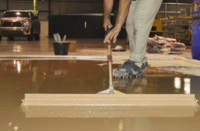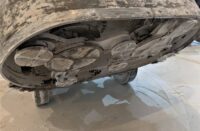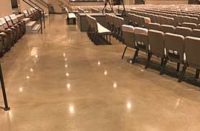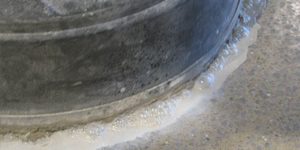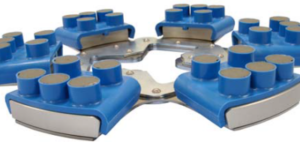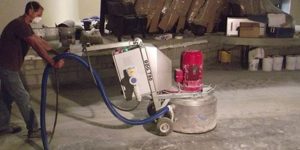Know your business and you’ll know what kind of equipment fits your needs.
Sounds simple enough, right? But when the business decision involves one of the largest and most important investments a polished concrete contractor will make — a grinding/polishing machine — an understanding of the business and its objectives is essential.
That’s a primary message from David Stephenson, a former contractor and now president of Polished Concrete Consultants, who advises contractors on a range of business and technical issues.
Jim Cuviello, a longtime polished concrete contractor and owner of Cuviello Concrete and Terrazzo Polishing, delivers a similar message. The polished concrete contractor’s market positioning — residential, commercial or both — is pivotal in determining strategic business decisions on core equipment investments.
What’s your line?
Stephenson has been there and done that, and knows polished concrete and its history from the early days of its rise to prominence in the decorative concrete trade.
“In the world of polished concrete, you have a couple of different types of contractors,” Stephenson says. “So you need to decide what kind of contractor you’ll be and what kind of market you’ll target.”
This boils down to:
- The contractor that specializes in larger projects and square-foot volume, or
- The contractor that seeks to build a custom-design type of business that makes its mark with artistry, creativity and skill.
This positioning strategy plays a central role in determining what kind of machines the contractor should consider, he says.
Porsche or pickup truck?
A sizeable share of the grinder market consists of high-performance machines that produce great-looking results, along with lighter weight and options that offer wide speed variability and a great deal of control. These units, typically belt driven, can turn out “super-good floors, high-quality floors,” Stephenson says. This kind of machine is “tuned for performance,” but can require more maintenance.
The other category of grinder consists of the “pickup truck” variety — robust, built heavier, used as much for demanding prep work or coatings and grout removal as for polishing and honing. These grinders are workhorses, churning the square footage and boasting durability and reliability. The polish is serviceable, but certainly not museum grade.
Stephenson recalls an occasion as a contractor some years ago where a machine of this type fell off a truck into a highway, and “it ran just fine. Years later it was still running, even though it had bounced down the highway.”
When looking to start up a polished concrete contracting business or add this component to a contractor portfolio, the business owner needs to ask whether the objective is an industrial-polishing focus — delivering acres of polished concrete in institutional buildings, office buildings, schools, big-box stores, warehouses and other large spaces. Or is the contractor’s business model built around smaller projects that feature artistry, skill, creative expression and unique concepts?
The contractor’s geographic market also figures into the business model and resulting equipment decision making, Stephenson says.
In a major metropolitan area such as Chicago, Houston and New York, logistics play a role. Is there room for a generator and the ability to move the equipment adequately? Does a propane-powered machine make more sense? And where is the greatest potential to pursue clients — residential and small-business customers or sprawling warehouses, big-box stores and office space?
“With smaller contractors, they may have gotten sold on a piece of equipment without knowing the kind of job they are going after, and find they have a high-performance grinder when they need a heavy-duty machine,” Stephenson says.
Right-sizing for the market profile
Cuviello, the founder of the Concrete Polishing Association of America, now part of the American Society of Concrete Contractors, says the contractor’s market focus can also factor into some very basic equipment functions.
“Is it residential, commercial or both?” Cuviello asks. In the residential market, three-phase electric power is rarely available on-site. The choice for the contractor is transporting a generator or using machines that run on 110-volt or 220-volt single-phase power. This, in turn, can translate into a need for a heavier power cord; heavier also means weightier.
What about the contractor’s range of services? If this includes heavy surface prep as well as polishing, a machine with adequate weight and power will be needed, Cuviello says.
Job size and surface dimensions also make a big difference in determining grinder decisions. Smaller machines make sense if buildings are divided into many rooms and tight corners are prevalent, while open areas of 1,000 square feet or more are best handled with a machine with a larger working dimension. On the other hand, a contractor could optimize productivity by using several smaller machines on one large project or multiple smaller projects, Cuviello says.
Do the research
Stephenson advises doing the research to find out what kind of equipment the manufacturer specializes in — and even look at the kinds of projects they profile on their website.
Once the business model takes shape, the owner can narrow the choice of grinding equipment to a few candidates. From there, it’s a matter of investigating the machine maker’s track record on quality, service and, of course, the price tag.
“Especially with polished concrete, price should be viewed as the least important thing,” Stephenson says. “One machine may cost thousands of dollars less than another similar grinder, but if one machine breaks down more than the other, the cost savings evaporate. The loss of just one job due to an equipment failure can amount to as much as the cost difference of the machines.”
Contractors nowadays are getting sales pitches from more and more overseas companies, especially from China. But Stephenson advises caution.
“When they break down, it’s harder to get parts,” he says. The contractor might buy the grinder and find a year later that it’s gathering dust in the shop, a victim of the difficulty of keeping it running.
For smaller companies, in particular, choosing the right kind of grinder is key. A larger contractor — one with eight or more grinders, for example — might carry a bigger, heavier-duty machine along with nimbler, high-performance models, Stephenson says. Smaller contractors may not enjoy that luxury.
“You’ve got to decide what you want to be — architectural or industrial.”
